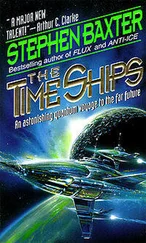Designing a probe that could return precise science data and yet survive being driven at speed into a rock wall was quite a feat, a project on which Bootstrap had spent a lot of money. But right now science lay in the future. The penetrators’ main purpose was fixing the O’Neill to Cruithne’s surface, mooring the ship like a smack to a pier.
Now Emma heard a whirr of winches. Languid vibrations snaked along the cables, and she could see the surface inch closer. One penetrator came loose in a puff of dust; its cable went slack and coiled away, out of sight.
There was the softest of shudders, a brief blur of dust.
Then there was only silence and stillness — and a piece of Cruithne framed in the window.
Malenfant came clambering up the fireman’s pole, his face split by a grin. “The O ‘Neill has landed.” He hugged her; she could see Michael was grinning, responding to Malenfant’s vigor and happiness.
“Now,” Malenfant said. “Now we go to work.”
The chains of fireflies, as they hauled giant loads of regolith like so many metallic dung beetles, were comical and inspiring.
Emma was amazed how quickly the fireflies were able to work in the peculiar environment of Cruithne. Autonomously controlled, with surprising grace and skill, they levered their way across the surface with their tethers and pitons and claws. And the low gravity allowed them to shift large masses with ease.
It was just hours before Emma was able to crawl through a tight fabric tunnel from the O ‘Neill and into the new dome.
She stood up and looked around. She was standing on plastic sheeting that merged seamlessly with the walls. The whole thing was just a fabric bubble thirty feet wide at the base, like an all-in-one plastic tent. The roof above her, ten feet up at its tallest, was a pale translucent yellow, supported by air pressure. The fireflies had thrown a cable net over the roof and then shoveled regolith over that, to a depth of three feet, for radiation shielding. Equipment, transferred from O ‘Neill, was piled up in the center of the dome.
The lighting, from yellow tritium bulbs, was utilitarian and harsh. There was a smell of burning, like autumn ash: that was asteroid dust, she knew, leaked into their hab environment despite all their precautions, thin fine stuff that was slowly oxidizing, burning in the air.
She knelt down. Regolith was visible through the floor, blurred lumps of coal-black rock. The crater floor had been scraped smooth by the fireflies before the dome was erected; she could see grooves and ridges where ancient ground had been raked like a flower bed in a suburban garden. She pushed a finger into the sheeting. It was very tough stuff, tougher than it looked; she was only able to make a dent of an inch or so. And as she pushed she felt herself lifting off the floor in reaction; Cruithne’s feeble gravity stuck her only gently to the ground.
Michael had crawled after her. He seemed relieved to be out of the ship. He started running around the perimeter of the dome — or rather he tried to run; with every step he went sailing into the air, bounced off the curving roof, and came floating back down again for another pace. After a few paces he started getting the hang of it, and he picked up speed, pacing and pushing against the ceiling confidently.
The shelter was crude. But Emma felt her spirits lift. After ninety days it was a profound relief not to be confined to the cramped metal cans of the O ‘Neill, for a while at least.
It also didn’t smell as bad as the O ‘Neill had become.
That night they had a party in the hab dome, raiding their precious store of candy bars and washing them down with Cruithne water.
The next day the four of them prepared to explore Cruithne.
Huddled together, they stripped naked — after ninety days, all shyness was gone, though Emma did feel unaccountably cold — and, clumsy in the low gravity, they began to help each other don their skinsuits.
Malenfant kept up a running stream of instructions. “Make sure you get it smoothed out. If the pressure isn’t distributed right you’ll have blood pooling.”
Emma’s skinsuit was just a light spandex coverall, like a cyclist’s gear. The material was surprisingly open mesh; if she held up her hand and stretched out her fingers she actually could see her flesh through fine holes in the weave. The spandex, a pale orange that turned blue around any rips, was used to avoid the outgassing and brittleness suffered by rubber in a vacuum. The suit had a hood and gloves and booties, and the pieces fit together with plastic zippers at her neck, wrists, and up her belly to her neck. The only thing she wore inside the suit was a catheter that would lead to a urine collection bag.
The light, comfortable skinsuits had replaced the old pressure garments — giant, stiff, body-shaped inflatable balloons — worn by earlier generations of space travelers. But it was important to have the skinsuit fit properly; the pressurization had to be equal all over her skin.
But this was actually old technology. Burn victims had long needed elasticated dressings that would apply a steady pressure over an extended area of the skin so that scarring occurred in a way beneficent to the patient. It didn’t surprise her to learn that an offshoot of Bootstrap had bought up a medical supply company from Toledo that had specialized in such stuff for decades and was now making a profit by selling better burn dressings back to the hospitals.
Over the top of the skinsuit came more layers, loose fitting and light. First there was a thermal-protection garment, a lacing of water-bearing tubes running over her flesh to keep her temperature even, and then a loose outer coverall, a micrometeorite protection garment. This actually had her name stitched on the breast, NASA-style: STONEY. She put on her bubble helmet with its gold sun visor, and her backpack, a neat little battery-powered rucksack with pumps and fans that could cycle the air and water around her suit for as long as twelve hours.
Now I actually look like an astronaut, she thought.
Malenfant made each of them, in turn, sit in their suits and go to vacuum in the hab’s small collapsible airlock. He called it the suits’ final acceptance test.
Then, the last checks complete, it was time to leave.
They squeezed into the airlock. Emma could feel oxygen blowing across her face, hear the warm hums and whirrs of her backpack.
Michael, beside her in the airlock, clutched her hand. But he showed no fear. He had seemed calm and controlled, in fact, since they had arrived at Cruithne. It was as if, now they had arrived, he knew why they were here, what they would find.
As if he were meant to be here.
Malenfant unzipped the airlock’s fabric door, rolled it down, and stepped forward.
Emma glimpsed frozen air sailing away into the vacuum, frozen particles of it glinting in the sunlight, as if this handful of molecules were trying to expand to fill all of infinite space. The last noises disappeared, save for her own breathing, loud in her bubble helmet, and the sounds that carried through her suit: the rustle of fabric, the slither of the skinsuit against her flesh when she moved.
Still gripping Michael’s hand, Emma pushed her head out of the hatch. The sun’s light flooded over her, astoundingly bright after months in the dingy interior of the O ‘Neill. She took a step out of the airlock, and, gentle as a snowflake, settled to the dirt of Cruithne.
Where her blue-booted feet hit the regolith, with dreamy slowness, she kicked up a little coal-black asteroid dirt. It sailed into the air — no, just upward — for a few feet, before settling back, following perfect parabolas.
The four of them, huddled together in their glowing white suits, were the brightest objects in the landscape, like snowmen on a pile of coal. But already the clinging black dust of the asteroid had coated their lower legs and thighs.
Читать дальше
Конец ознакомительного отрывка
Купить книгу












